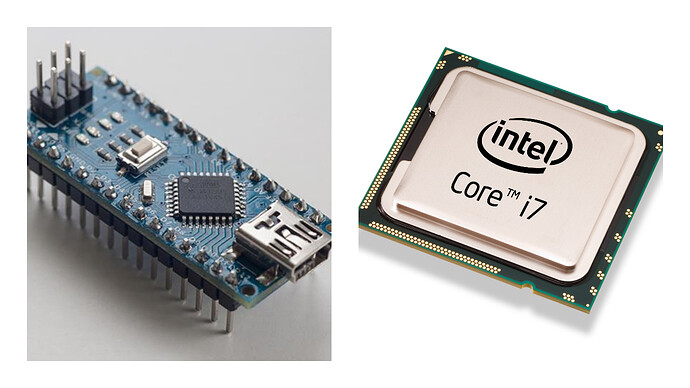History
The journey of both microcontroller and microprocessor began when two smartest engineers named Mohamed M. Atalla and Dawon Kahng at Bell Labs designed the first MOSFET (metal-oxide-semiconductor field-effect transistor) in 1959. In 1960, Mohamed M. Atalla proposed the concept of Integrated Circuit fabricated from MOSFET. Hereafter, the Integrated circuits have undergone several changes. The first single-chip microprocessor was the Intel 4004, released on a single MOS LSI chip in the year 1971. The first microcontroller TMS1000 was created by Texas Instruments in the year 1971.
Difference between microprocessor and microcontroller
Microprocessors are integrated circuits capable of performing Arthematic and logical operations. Microprocessor consists of an ALU, register array, and a control unit. The ALU performs arithmetical and logical operations on data in the memory or data received via an input device. These microprocessors don’t have any internal RAM, ROM, and other peripheral on the chip. These peripherals are connected externally to a microprocessor on a motherboard. For example, the Intel/AMD processor inside your laptop.
On the other hand, microcontrollers come with ALU, RAM, ROM, Timers, Analog to digital converter (ADC), Digital to analogue converter (DAC) and other different communication units embedded on a single chip. The atmega328p on an Arduino UNO board is a good example for the microcontroller.
Microprocessors are general-purpose devices, which means the relationship between input and output are not defined. To be more specific, it can be used for all sorts of applications like playing games, image/video editing, office works, etc where the relationship between input and output are not defined. These chips are used, when high computational power is a need, hence the clock frequency of microprocessor ranges in GHz and the consumption of RAM and ROM is also high. They are used in personal computers to servers which automate billing in large corporations.
[ Interesting fact: The AMD Piledriver based FX-8370 microprocessor can be overclocked to a maximum frequency of 8.723 GHz. ]
In microcontrollers, the relationship between inputs and outputs are defined. It is designed to do a specific task, which makes it the core of all embedded systems. For example, turn on/off a fan depending on the data from a thermistor. The clock frequency of a microcontroller ranges from 4 MHz to 240 Mhz. These microcontrollers are employed in the washing machine, calculators, Pendrive, TV remote, microwave ovens, cars, bikes etc. Since the applications are very specific, the consumption of RAM & ROM is significantly low. This, in turn, reduces the size and the cost.
In terms of architecture, microcontrollers are based on Harvard architecture where program memory and data memory are separated while microprocessors are based on the Von Neumann architecture where program instructions and data share the same memory and pathways.
The power consumption in the microprocessor is much higher than the microcontroller due to its high computational speed and external components.
